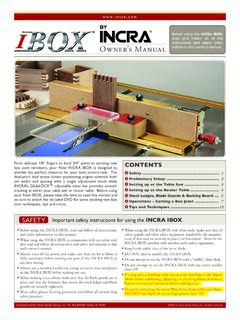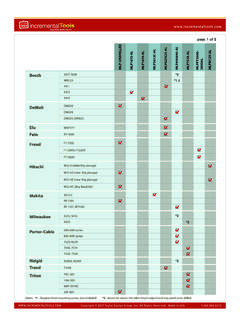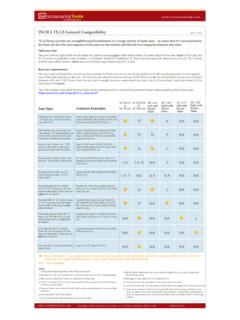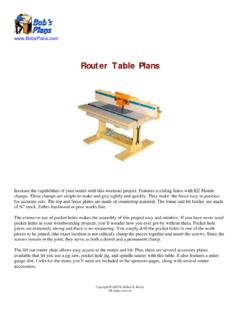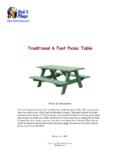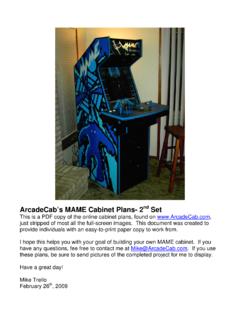Transcription of Pivot-Door Downdraft Cabinet Plans - Incra Tools
1 W w w . i n c r a . c o mPivot-Door Downdraft Cabinet Plansrev. 2008 by Taylor Design Group. All rights CabinetIntroductionThis simple Downdraft -style dust collection Cabinet is a great way to keep your shop cleaner and keep your router quieter. The simple design can be easily constructed from a wide variety of materials available at home centers and hardware stores. There are no conventional hinges to install, and the all-wood joinery allows a fast, satisfying Choices: For the Cabinet housing, good-quality birch or oak-veneer plywood are recommended, but MDF also works well. The door panel can be an edge-glued hardwood panel or plywood (with edge banding for neatness). MDF has the advantage of being inexpensive, flatter than plywood, and more consistent for thickness.
2 It can also be quite attractive with a few coats of polyurethane Choices: A remote router switch with a length of cord on the female end is ideal, but a short, heavy (12ga or 14ga.) extension cord can also bring power into the Cabinet . The hardware and door catches are widely available at hardware stores and home centers. For the nuts and bolts, many better hardware stores carry stainless steel or chrome-plated hardware to add some style to the 1 ClosedOpenExploded View w w w . i n c r a . c o mpage 2 Materials:Lumber Cutting List:Part Qty. T W L MaterialSide Panels 2 3/4 14-1/16 14-3/4 Veneered plywood or MDFBack Panel 1 3/4 10-3/8 13-3/16 Veneered plywood or MDFB ottom Panel 1 3/4 10-3/8 14 Veneered plywood or MDFF ront Brace 2 3/4 2-1/4 10-3/8 * Veneered plywood or MDFDoor Panel 1 3/4 11-7/8 13-1/2 Edge-glued hardwood,veneered plywood, or MDF* Length of Front Braces should perfectly match the width of bottom plywood or MDF, roughly 26 x 46 Dust collection fitting Rockler #21025 or similar Remote 15 Amp router switch (optional but recommended)
3 Rockler #20915 Woodcraft #141938 Bench Dog #04-028(4) Corner braces - National Hardware #N227-405 2 x 5/8 or similar Note: Corner brace screws must be no longer than 3/4 when attaching the Cabinet to an Incra stand-alone router table and no longer than 1/2 when installing the Cabinet on an Incra TS router table. (1) Cabinet door pull or knob (1) Magnetic or roller Cabinet door catch(1) 5/16 -18 x 2 socket head cap screw (2) 5/16 fender washers (1) 5/16 -18 nylon insert lock nut (1) 1/4 -20 x 1-1/4 (or 1-1/2 ) (1) 1/4 -20 nylon insert locknut (1) 1/4 flat washer w w w . i n c r a . c o mpage 31. Think FirstTake a few moments to read the instructions in their entirety. A better understanding of the entire project will allow you to work more efficiently and accurately during the construction.
4 Here are a few general guidelines: a. This Cabinet is intended to be used with Incra offset-style router tables and router table stands. It can also be installed on Incra TS Router Tables. b. The design assumes that the router table stand is attached to the router table using the dimensions specified in the router table stand instructions. c. A crosscutting sled will allow better control than a miter gauge for squaring up the larger components. d. Widths of rabbets and dados are approximately 3/4 . The actual width should be matched to the exact thickness of your material to produce the best fitting Separate the Groups of PartsStarting with a section of plywood at least 26 x 46 , make rip cuts along the grain to rough widths of 14-5/8 a n d 10-7/8 to separate the two groups of 2: Parts Layout3.
5 Dimension the Large PartsCut the Cabinet sides, back, and bottom to their final dimensions. The 13-3/16 length for the back panel will initially be too long and will be trimmed to fit during the test fit. The extra length will compensate for plywood bottom panels thinner than a true 3/4 .Step 3: Dimension SidesGrain Direction10-7/8 3/4 x 48 x 48 PlywoodFront Brace(top)Front Brace (bottom)BackDoorLeftSideBottomRightSide1 4-5/8 Grain DirectionBack13-3/16 10-3/8 Bottom14 10-3/8 Grain DirectionLeft SideRight Side14-1/16 14-3/4 14-1/16 14-3/4 w w w . i n c r a . c o mpage 44. Dimension the Smaller PartsCut the front braces and door to their final dimensions from the remaining material. Note that the length of the front braces should exactly match the width of the bottom 4: Dimension Small Parts5.
6 Stay OrientedMark the edges of the Cabinet sides so you can easily iden-tify the top, front (the edge nearest the door), back, and bottom of the Cabinet . The sides 14-3/4 long dimension runs vertically in the finished Cabinet , and the two sides will be mirror images of one Set up the JoineryRaise a 1/2 -diameter straight router bit or similar width table saw dado set to 3/8 above the table. The 3/8 cutter height will be used for the all of the rabbets and dados. Don t forget to use a wooden sub fence if you ll be cutting the rabbets with a table saw and dado Cut the Rabbet on the Front Edge of the CabinetBe sure to cut the rabbet down the longer 14-3/4 dimensionon the Cabinet sides. a. Set the fence flush with the outside edge of the bit (so none of bit is exposed), then back the fence away to take a 1/8 scoring pass on the front edge of each Cabinet side.
7 B. Back the fence away to expose 1/2 of the bit and take a second pass on each Cabinet side. c. Set the fence position for the final pass to widen the rabbet to a width equal to the thickness of the front braces (probably slightly less than 3/4 , if you re using plywood).8. Cut the Dados for the Back Panel and Bottom Panel d. Set the fence the 7/8 from the nearest edge of the cutter to place the dados the correct distance from the boards edges. Each pass removes a lot of lumber, so be conservative with the feed rate through the cutter. e. Make the setup for the second pass by locking the fence slightly further from the router bit (1/4 or less, depending on material thickness). Make a second pass to bring the dados to the proper width to accept the bottom and back 5 - 8: Rabbets and DadosDoor13-1/2 Front Brace (top)Front Brace (bottom)10-3/8 10-3/8 2-1/4 2-1/4 Grain Direction11-7/8 1.
8 Mark front, rear and bottom ofcabinet sides. Note tahat you ll bemaking two mirror-imaged Set a 1/2 straightrouter bit or tablesaw dado set to aheight of 3/8 .3. Make a lightscoring pass alongthe front edge ofeach Cabinet side,then cut the rabbetin two passes tomatch the thick-ness of the 3/4 (approx.)3/8 RightCabinetSideRear Front14-1/16 7/8 3/4 3/4 4. Cut thegrooves for the bottom andback panels tothe Rear w w w . i n c r a . c o mpage 59. Cut Access for the Power CordRaise the router bit to just over 3/4 so it cuts through the entire thickness of the plywood. Set the fence about 4 from the bit. Slowly feed the Cabinet side into the bit to cut a small notch for the power 9: Power Cord Access10. Prepare the Bottom for Dust CollectionMark the bottom panel so you can identify which edge faces the front of the Cabinet .
9 Cut the opening in the bottom panel to match the dust collection fitting you intend to use (use a 4 fitting; a 2-1/2 hose won t move enough air volume). Dimensions shown are for Rockler s #21025 fitting. A fitting offset toward the sides of the Cabinet will provide slightly better performance than one that s mounted directly beneath the the fitting with screws or construction a woodworking dust collection fitting is not available locally, a PVC closet flange with an outside diameter that accepts 4 dust collection hose can be purchased in the plumbing aisles of nearly any home Hinge the DoorMark the top and left end of the lower front brace. Drill the holes for the door pivot in the lower front brace and door at the appropriate locations.
10 A 21/64 drill bit is ideal, but an 11/32 bit will also 10: Dust CollectionStep 11: Hinge DrillingRockler Dust Port#21025 (8 x 8 )6-9/16 1-1/2 2-7/8 10-3/8 14 6-1/2 Rear FrontFront Brace(bottom)Approx. 4 Left CabinetSideRear FrontLeft EdgeTop EdgeBottom FrontBrace3/4 1-3/4 21/64 Door Panel2-1/2 21/64 3-5/8 w w w . i n c r a . c o mpage 612. Bring the Parts TogetherTest-fit the Cabinet assembly and gather the necessary clamps and materials for the the length of the back panel so it s flush at the top of the Cabinet while resting against the bottom 12: Dry Assembly13. Assemble the CabinetBegin the glue up with the Cabinet on its side. Position the bottom, back, and lower front brace in their respective rabbets and grooves.


